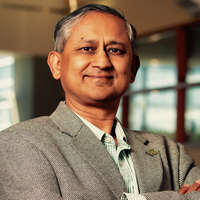
Amit Sheth
Highlights [Oct 2017]
* As a researcher: With an H-index of 112, Prof. Sheth is was the top 100 computer scientists and engineers in the world (68th in the US) in 2018, placing him among a small handful of top researchers in the US in his areas of AI and Big Data. The majority of his $30+million in research funds has come from the most competitive and prestigious sources: NIH and NSF. This level of funding places him among the top-funded academic leaders worldwide.
* As an educator: Prof. Sheth has fostered exceptional careers for his 30Ph.D., about the same number of MS Thesis advisees, and >15 postdocs— they have typically become tenured/tenure-track faculty at Carnegie R1 universities, or begin their career as researchers/scientists in top companies where they compete successfully with graduates from top 10/20 schools, or (a few) launch start-ups as successful entrepreneurs. During the 10 years starting his move to Wright State University, his research grants funded 1,036 months of GRA (which translates to 148 quarters (until 2012) and 148 semesters of GRA support. He has led major initiatives at key times to start new academic programs.
* As an entrepreneur, leader, and administrator: He has founded three startups by licensing his university research-derived technology, and has cofounded/advised two additional companies. He has consistently recruited high-quality and exceptionally productive team members when he was a manager in industry, an entrepreneur, and in academia (especially as an Ohio Eminent Scholar with faculty lines and as the director of a lab, a center and an institute. He has executive experience as the CEO/President, Founder, or Board Member of technology companies, with his roles spanning all aspects of organization building, including investment raising, finance, marketing and sales, recruiting, and technology development. His startups have received millions in investment and have invested many millions more in local job creation/payroll where his companies have operated.
More info at:
http://aiisc.ai/amit
http://www.linkedin.com/in/amitsheth
https://scholar.google.com/citations?hl=en&user=2T3H4ekAAAAJ
http://www.slideshare.net/apsheth/
Twitter: http://twitter.com/#!/amit_p
Address: Search for "AIISC" on Google Map
* As a researcher: With an H-index of 112, Prof. Sheth is was the top 100 computer scientists and engineers in the world (68th in the US) in 2018, placing him among a small handful of top researchers in the US in his areas of AI and Big Data. The majority of his $30+million in research funds has come from the most competitive and prestigious sources: NIH and NSF. This level of funding places him among the top-funded academic leaders worldwide.
* As an educator: Prof. Sheth has fostered exceptional careers for his 30Ph.D., about the same number of MS Thesis advisees, and >15 postdocs— they have typically become tenured/tenure-track faculty at Carnegie R1 universities, or begin their career as researchers/scientists in top companies where they compete successfully with graduates from top 10/20 schools, or (a few) launch start-ups as successful entrepreneurs. During the 10 years starting his move to Wright State University, his research grants funded 1,036 months of GRA (which translates to 148 quarters (until 2012) and 148 semesters of GRA support. He has led major initiatives at key times to start new academic programs.
* As an entrepreneur, leader, and administrator: He has founded three startups by licensing his university research-derived technology, and has cofounded/advised two additional companies. He has consistently recruited high-quality and exceptionally productive team members when he was a manager in industry, an entrepreneur, and in academia (especially as an Ohio Eminent Scholar with faculty lines and as the director of a lab, a center and an institute. He has executive experience as the CEO/President, Founder, or Board Member of technology companies, with his roles spanning all aspects of organization building, including investment raising, finance, marketing and sales, recruiting, and technology development. His startups have received millions in investment and have invested many millions more in local job creation/payroll where his companies have operated.
More info at:
http://aiisc.ai/amit
http://www.linkedin.com/in/amitsheth
https://scholar.google.com/citations?hl=en&user=2T3H4ekAAAAJ
http://www.slideshare.net/apsheth/
Twitter: http://twitter.com/#!/amit_p
Address: Search for "AIISC" on Google Map
less
Related Authors
Arnab Bhattacharya
IIT Kanpur
Vasant G Honavar
Pennsylvania State University
Lisa Gualtieri
Tufts University
Emre San
Istanbul 29 Mayis University
Prabhakar TV
IIT Kanpur
David Laniado
Eurecat
Paul Groth
Vrije Universiteit Amsterdam
Pietro Li Causi
University of Siena / Università di Siena
METE YILDIZ
Hacettepe University
Hatice ŞİRİN
Ege University
InterestsView All (22)










Uploads
Papers by Amit Sheth
contexts: the US, European Union and India. For example, he is involved in the CityPulse project
that aims to provides innovative smart city applications by adopting an integrated approach to the
Internet of Things and the Internet of People. Prof. Sheth is the Executive Director of the Ohio
Center of Excellence in Knowledge-enabled Computing at Wright State University, which has a very
high global research impact, and he is currently on a six week visit to the University of Otago. Prof.
Sheth is involved in multidisciplinary research with real-world impacts across a range of fields
including: healthcare and life sciences; defence and intelligence, manufacturing science; and,
human, social and economic development. In addi5on to his academic career, Prof. Sheth has
founded and managed three start-up companies and held senior positions in the research and
development teams at Bellcore, Unisys, and Honeywell. You can read more about Professor Sheth’s
work at hSp://knoesis.wright.edu/amit/
I will review: 1) understanding and analysis of informal text, esp. microblogs (e.g., issues of cultural entity extraction and role of semantic/background knowledge enhanced techniques), and 2) how we built Twitris, a comprehensive social media analytics (social intelligence) platform.
I will describe the analysis capabilities along three dimensions: spatio-temporal-thematic, people-content-network, and sentiment-emption-intent. I will couple technical insights with identification of computational techniques and real-world examples using live demos of Twitris (http://twitris2.knoesis.org).
--------
Opening talk at Singapore Symposium on Sentiment Analysis (S3A), February 6, 2015, Singapore. http://s3a.sentic.net/#s3a2015
Big Data has captured a lot of interest in industry, with the emphasis on the challenges of the four Vs of Big Data: Volume, Variety, Velocity, and Veracity, and their applications to drive value for businesses. Recently, there is rapid growth in situations where a big data challenge relates to making individually relevant decisions. A key example is human health, fitness, and well-being. Consider for instance, understanding the reasons for and avoiding an asthma attack based on Big Data in the form of personal health signals (e.g., physiological data measured by devices/sensors or Internet of Things around humans, on the humans, and inside/within the humans), public health signals (information coming from the healthcare system such as hospital admissions), and population health signals (such as Tweets by people related to asthma occurrences and allergens, Web services providing pollen and smog information, etc.). However, no individual has the ability to process all these data without the help of appropriate technology, and each human has different set of relevant data!
In this talk, I will forward the concept of Smart Data that is realized by extracting value from Big Data, to benefit not just large companies but each individual. If I am an asthma patient, for all the data relevant to me with the four V-challenges, what I care about is simply, “How is my current health, and what is the risk of having an asthma attack in my personal situation, especially if that risk has changed?” As I will show, Smart Data that gives such personalized and actionable information will need to utilize metadata, use domain specific knowledge, employ semantics and intelligent processing, and go beyond traditional reliance on ML and NLP.
For harnessing volume, I will discuss the concept of Semantic Perception, that is, how to convert massive amounts of data into information, meaning, and insight useful for human decision-making. For dealing with Variety, I will discuss experience in using agreement represented in the form of ontologies, domain models, or vocabularies, to support semantic interoperability and integration. For Velocity, I will discuss somewhat more recent work on Continuous Semantics, which seeks to use dynamically created models of new objects, concepts, and relationships, using them to better understand new cues in the data that capture rapidly evolving events and situations.
Smart Data applications in development at Kno.e.sis come from the domains of personalized health, energy, disaster response, and smart city. I will present examples from a couple of these.
2 min. video on a Personalized Digital Health application (Asthma control in Children): https://www.youtube.com/watch?v=mATRAQ90wio
Also see: http://knoesis.org/amit/hcls for related information.
For harnessing volume, I will discuss the concept of Semantic Perception, that is, how to convert massive amounts of data into information, meaning, and insight useful for human decision-making. For dealing with Variety, I will discuss experience in using agreement represented in the form of ontologies, domain models, or vocabularies, to support semantic interoperability and integration. Lastly, for Velocity, I will discuss somewhat more recent work on Continuous Semantics, which seeks to use dynamically created models of new objects, concepts, and relationships and uses them to better understand new cues in the data that capture rapidly evolving events and situations.
Smart Data applications in development at Kno.e.sis come from the domains of personalized health, energy, disaster response and smart city. I will present examples from a couple of these.
At Kno.e.sis, we have collaborations with clinicians in growing number of specializations (Cardiovascular, Pulmonology, Gastroenterology) to study personalized health decision making that involve the use of real-world patient data, deep background knowledge and well targeted clinical applications. For example:
For a patient discharged from hospital with Acute Decompensated Heart Failure, can we compute post hospital discharge risk factor to reduce 30-day readmissions?
For children with Asthma, can we predict an impending attack to enable actions that prevent an attack reducing the need for post-attack symptomatic relief?
For Parkinson’s Disease, can we characterize the progression to adjust medication and therapeutic changes?
The above provides the context for a research agenda around what I call Smart Data, which (a) provides value from harnessing the challenges posed by volume, velocity, variety and veracity of Big Data, in-turn providing actionable information and improve decision making, and/or (b) is focused on the actionable value achieved by human involvement in data creation, processing and consumption phases for improving the Human experience. In describing Smart Data approach to above heath applications, I will cover the following technical capabilities that adds semantics to enhance or complement traditional NLP and ML centric solutions:
* Semantic Sensor Web- including semantic computation infrastructure, ability to semi-automatically create domain specific background knowledge (ontology) from unstructured data (e.g., EMR), and automatically do semantic annotation of multimodal and multisensory data
* Semantic perception – convert low level signals into higher level abstractions using IntellegO framework that utilizes domain knowledge and hybrid abductive/deductive reasoning
* Intelligence at Edge - perform scalable and efficient semantic computation on resource constrained devices
In this talk, I will provide a series of snapshots of efforts in which semantic approach and technology is the key enabler. I will emphasize real-world and in-use projects, technologies and systems, involving significant collaborations between my team and practicing clinicians and healthcare solution provides. Examples include:
• Active Semantic Electronic Medical Record (ASEMR paper, ASEMR demo): This system deployed at Athens Heart Center and its partners since 2006 uses automatic semantic annotation with respect to three ontologies, and rule-based EMR quality and error alert system, leading to higher quality EMRs, fewer errors and time saving in clinical practice.
• Data Mining of Cardiology data: Data driven knowledge acquisition for domain knowledge enrichment leading to comprehensive cardiology ontology development, its use in finding and correcting NLP processing errors of EMRs, and development of a commercial semantic search engine in collaboration with ezDI supporting core measures and other key challenges and opportunities related to the Affordable Healthcare Act.
• Semantic Search, Browsing and Literature Based Discovery: A semantic search and browsing technology embodied in Cuebee, Doozer, SCOONER and iExplore tools provide ability to harvest and utilize extensive background knowledge for semantic search and contextual browsing to provide insights from scientific literature. SCOONER was used by AFRL biomedical researchers in human performance and cognition. A recent work with NLM has demonstrated recovering and decomposing Swanson's Raynaud Syndrome-Fish Oil Hypothesis semi-automatically.
• PREscription Drug abuse Online Surveillance and Epidemiology (PREDOSE): development of semantic techniques and tools for analyzing user generated content on social media related to the illicit use of pharmaceutical opioids, that recently led to discovery of Extra-Medical Use of Loperamide. In collaboration with Center for Interventions, Treatment and Addictions Research (CITAR) at WSU.
• kHealth: development of a knowledge-enhanced sensing and mobile computing applications (using low cost sensors and smartphone), along with ability to convert low level observations into clinically relevant abstractions. One of the early-stage ongoing research involves using kHealth for reducing preventable ADHF readmissions and asthma management. ADHF study in collaboration with Ohio State Wexner Medical Center.
More at http://knoesis.org/amit/hcls
For achieving energy sustainability, Smart Grids are known to transform the way we generate, distribute, and consume power. Unprecedented amount of data is being collected from smart meters, smart devices, and sensors all throughout the power grid. I will discuss the central question of deriving Value from the entire smart grid data deluge by discussing novel algorithms and techniques such as Semantic Perception for dealing with Velocity, use of ontologies and vocabularies for dealing with Variety, and Continuous Semantics for dealing with Velocity. I will discuss scenarios that exemplify the process of deriving Value from Big Data in the context of Smart Grid.
"Amit Sheth, "Transforming Big Data into Smart Data: Deriving Value via harnessing Volume, Variety and Velocity using semantics and Semantic Web," keynote at the 21st Italian Symposium on Advanced Database Systems,
June 30 - July 03 2013, Roccella Jonica, Italy. Also invited talks given in Universities in Spain and Italy in June 2013.
Highlight: How to harness Smart Data that is actionable, from the Voluminous Big Data with Velocity and Variety-- using Semantics and the Semantic Web core to bring Human-Centric Computing in practice.
Abstract from: http://www.sebd2013.unirc.it/invitedSpeakers.html
Big Data has captured much interest in research and industry, with anticipation of better decisions, efficient organizations, and many new jobs. Much of the emphasis is on technology that handles volume, including storage and computational techniques to support analysis (Hadoop, NoSQL, MapReduce, etc), and the challenges of the four Vs of Big Data: Volume, Variety, Velocity, and Veracity. However, the most important feature of data, the raison d'etre, is neither volume, variety, velocity, nor veracity -- but value. In this talk, I will emphasize the significance of Smart Data, and discuss how it is can be realized by extracting value from Big Data. To accomplish this task requires organized ways to harness and overcome the original four V-challenges; and while the technologies currently touted may provide some necessary infrastructure-- they are far from sufficient. In particular, we will need to utilize metadata, employ semantics and intelligent processing, and leverage some of the extensive work that predates Big Data. For Volume, I will discuss the concept of Semantic Perception, that is, how to convert massive amounts of data into information, meaning, and insight useful for human decision-making. For dealing with Variety, I will discuss experience in using agreement represented in the form of ontologies, domain models, or vocabularies, to support semantic interoperability and integration, and discuss how this can not simply be wished away using NoSQL. Lastly, for Velocity, I will discuss somewhat more recent work on Continuous Semantics , which seeks to use dynamically created models of new objects, concepts, and relationships and uses them to better understand new cues in the data that capture rapidly evolving events and situations.
Additional background at: http://knoesis.org/vision > SmartData and "Semantics-empowered Approaches to Big Data Processing for Physical-Cyber-Social Applications," http://www.knoesis.org/library/resource.php?id=1889 ."
The proper role of technology to improve human experience has been discussed by visionaries and scientists from the early days of computing and electronic communication. Technology now plays an increasingly important role in facilitating and improving personal and social activities and engagements, decision making, interaction with physical and social worlds, generating insights, and just about anything that an intelligent human seeks to do. I have used the term Computing for Human Experience (CHE) to capture this essential role of technology in a human centric vision. CHE emphasizes the unobtrusive, supportive and assistive role of technology in improving human experience, so that technology “takes into account the human world and allows computers themselves to disappear in the background” (Mark Weiser).
In this talk, I will portray physical-cyber-social (PCS) computing that takes ideas from, and goes significantly beyond, the current progress in cyber-physical systems, socio-technical systems and cyber-social systems to support CHE. I will exemplify future PCS application scenarios in healthcare and traffic management that are supported by (a) a deeper and richer semantic interdependence and interplay between sensors and devices at physical layers, (b) rich technology mediated social interactions, and (c) the gathering and application of collective intelligence characterized by massive and contextually relevant background knowledge and advanced reasoning in order to bridge machine and human perceptions. I will share an example of PCS computing using semantic perception [4], which converts low-level, heterogeneous, multimodal and contextually relevant data into high-level abstractions that can provide insights and assist humans in making complex decisions. The key proposition is to explain that PCS computing will need to move away from traditional data processing to multi-tier computation along data-information-knowledge-wisdom dimension that supports reasoning to convert data into abstractions that humans are adept at using.
In this talk, I provide a series of snapshots of efforts in which semantic approach and technology is the key enabler. I emphasize real-world and in-use projects, technologies and systems, involving significant collaborations between my team and biomedical researchers or practicing clinicians. Examples include:
• Active Semantic Electronic Medical Record
• Semantics and Services enabled Problem Solving Environment for T.cruzi (SPSE)
• Data Mining of Cardiology data
• Semantic Search, Browsing and Literature Based Discovery
• PREscription Drug abuse Online Surveillance and Epidemiology (PREDOSE)
• kHealth: development of a knowledge-enhanced sensing and mobile computing applications (using low cost sensors and smartphone), along with ability to convert low level observations into clinically relevant abstractions.
Regarding the evolution of the Web and semantic computing, the Web started as a web of pages, and evolved through the years to be a web of databases, of resources, people, and finally a web of sensors, devices, and interoperable things. We have introduced new types of heterogeneity. The Semantic Web is used in the following areas of health care and life sciences: clinical observation interoperability, biomedical informatics and bioinformatics, exploiting clinical and biomedical data, open biomedical and clinical ontologies, and capturing agreement among people. Some project examples include the following:
• Project 1: Athens Heart Center. Has been actively using Semantic Web for clinical decisionmaking since 2006. Uses an “active semantic EMR” and a drug ontology hierarchy.
• Project 2: National Institutes of Health. Uses queries across integrated data sources; enriching data with ontologies for integration, querying, and automation; and uses ontologies beyond vocabularies, using the power of relationships. Annotations are very important for this project.
• Project 3: National Institutes of Health. Understanding the genetic basis of nicotine dependence. Integrates gene and pathway information and shows how three complex biological queries can be answered by the integrated knowledge base. Semantic Web technologies support information integration and make it easy to create semantic mash-ups (semantically integrated resources).
• Project 4: Center for Tropical and Emerging Global Diseases. Semantics and services enabled problem solving environment for Trypanosoma cruzi human parasites. Uses contextually relevant information, and extraction and annotation using an ontology.
• Project 5: Collaboration between Kno.e.sis and Center for Interventions, Treatment and Addictions Research at Wright State University. Describes drug users’ knowledge, attitudes, and behaviors related to illicit use of OxyContin®. Describes temporal patterns of nonmedical use of OxyContin® tablets as discussed on Web-based forums.
• Project 6 (future project): Agile clinical pathways, providing physicians with contextually relevant information. Volatile nature of execution environments; may have an impact on multiple activities/tasks in the workflow; HF pathway; new information about diseases and drugs becomes available; affects treatment plans, drug-drug interactions; need to incorporate the new knowledge into execution; capture the constraints and relationships between different tasks activities.
• Project 7: Project HERO (Helpline for Emergency Response Operation). Addresses medical awareness in rural India. Matching medical requirements with availability of medical resources for patients seeking for immediate medical help.
Ora Lassila:
Some of the difficulties with the Semantic Web that have been encountered in the last 10 years include the following:
• Semantic Web is difficult to evangelize. Specific problems typically have solutions that do not require Semantic Web technologies. However, Semantic Web is attractive for “future proofing”; it allows us to do things that provide extensibility and will function in the face of unanticipated things. Semantic Web can be a solution to those problems and situations that we have yet to define.
• Semantic Web technology can be difficult to adopt. There is a lot of resistance for numerous reasons, including cultural resistance, unfamiliar technology, unclear business models, and technical challenges.
This is not meant to be discouraging. What makes Semantic Web technology attractive and worth pursuing is the idea of serendipity, which is the defining characteristic of Semantic Web technology. Can we have a system that has a chance of interoperating with systems or devices that we do not know will exist at the time we design our system. Then there is serendipity in information reuse. We produce information for one purpose, but someone else can come along and use the information for a different purpose. This also applies to information integration. We have observed that simple forms of information can be tremendously helpful when you do information integration. But you have to have a representational framework. Semantic Web was designed to be domain neutral.
Amit Sheth:
A future interoperability challenge is 360 degree health, including financial aspects, clinical care, follow-up, lifestyle, genetic testing, clinical trials, and social media. Clinical care is a small part of it.
There are many stakeholders in Semantic Web technology, including government, universities, pharmaceutical companies, patients, the public, hospitals, doctors, and clinical research organizations. For each component in 360-degree health care, we have data, processes, knowledge, and experience. Interoperability solutions need to encompass all these. Possibly the largest growth in data will be in sensors and social content, as well as extensive use of mobile phones.